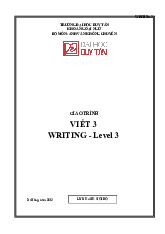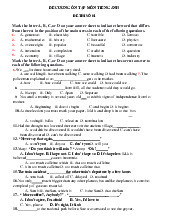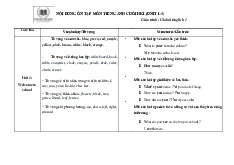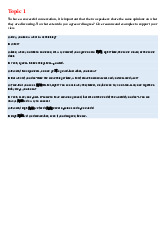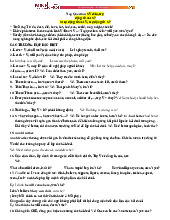






Preview text:
lOMoAR cPSD| 47708777
MODULE 2: EMAIL WRITING
Email is a system of sending written messages electronically from one computer to another. Email
is an abbreviation of ‘electronic mail’. (Collins)
1. INSTRUCTIONS FOR WRITING AN EMAIL
In this part of the test, you are given an email from an English friend or relative, and you are
asked to respond to it in about 100 – 120 words. This email contains annotations which help
you identify exactly what you need to respond to.
As regards the topics, they are usually not very difficult, as you are expected to write at an
intermediate level about topics you are familiar with: sports, hobbies, TV programmes,
weather, your town / city, best friend etc . Here is a sample email:
You must answer this question. Write your answer in about w
100 ords on the answer sheet.
Read this email from your English-speaking friend Sandy
and the notes you have made. From: Sandy To: Subject: Your visit! Me too Hi,
I’m so excited that you’re coming to stay with me for a week!
On your first evening here, there’s a rock concert in our
town. Say which
Would you like to go to the concert or would you prefer us to No, I prefer relax at home? Because
Also, shall we go climbing in the mountains while you’re here? Ask
Let me know if you have any questions. Sandy… See you soon Sandy
Write your email to Sandy using all the notes
As you can see in the example above, we have received an email from a person so-called Sandy,
who is a friend of ours. In addition, we have made some annotations, which are the points we
need to address in your email: • Me too! • Say which I prefer • No, because… lOMoAR cPSD| 47708777 • Ask Sandy… 2. EMAIL STRUCTURE
The first thing you need to know is the different parts of an email, and these are: •
Greetings: we greet the other person (i.e. say “hi” or “hello”), dear….. •
Opening paragraph: we react to the other person’s news and ask them how they are
feeling and whatever else you feel is appropriate. •
Main paragraph 1: in this paragraph we deal with the first important point, which we can identify in the instructions. •
Main paragraph 2: if there is a different point to deal with, this paragraph will do so.
( We might have more main paragraphs, depending on the task. ) •
Closing paragraph: in this paragraph we “start” to say goodbye by wishing the other
person well and asking them to reply to your email. •
Farewell/ Goodbye: we use a short expression to say goodbye. •
Signature: we sign the email with our name. 3. SAMPLE EMAIL
Let’s take a look at the following example of the email where we can see an answer to the sample task we saw above: From: Dũng To: Sandy Subject: my visit Hi Sandy, Greeting
Thanks a lot for writing back. I’m also really excited about visiting you! Opening p
On my first evening, I’d like to relax at home. I will probably be very tired Main p.1
from the trip, so I need to rest and get ready for the other days. Is that okay?
As for climbing, I’m afraid I can’t. I forgot to tell you, but I hurt my knee l ast Main p.2
week, so I can’t do sport now.
How about visiting some art galleries in your town? If you want, we could Main p.3
go. You know I love art! What do you think? Closing p.
Well, I have to go now, but please let me know what you think. Take care, Farewell Luis Signature lOMoAR cPSD| 47708777
In the example above, the different parts of an email are well defined. It’s important that
the writing is visually appealing, apart from having good grammar and vocabulary. This
means that the paragraphs should be well defined, with a space in between, and that you
should know when to break lines. This is especially important after greetings, after opening
and closing paragraphs, and after saying goodbye. This will make your text visually appealing,
as it will look like a real email.
4. EXPRESSIONS TO USE IN AN EMAIL
In this section, we are going to focus on different expressions to use in the different parts
of the email. While the main paragraphs will vary completely depending on the topic of the
writing, most of the other parts in the email can be practised and memorized almost completely. Let’s take a look: 4.1. GREETINGS
In order to start the email, we can used different expressions, which are really typical and easy
to remember. We have 3 basic ways to greet in this kind of writing, which is usually for a friend or family member: Hi John, Hello John, Dear John,
Note: Notice how “Hi” is less formal than “Hello” or “Dear”. Also, don’t forget to write a
comma (,) right after greeting your friend or relative. After greeting the addressee (i.e. the
person who will read the email), you must start the opening paragraph in a new line. 4.2. OPENING PARAGRAPH
The opening paragraph is the place to react to your friend’s or relative’s email. In order to
do so, you can use a number of different expressions. Here we have some examples:
It’s nice / great / good to hear from you.
It’s nice / great / good to read your email.
I’m glad to hear your news.
I’m excited about … (your news.)
It’s great to hear that…
I’m sorry to hear that…
I’m really sorry to read your news.
Thanks a lot for writing!
It was good to receive your email.
Thank you very much for your email.
Also, it’s a good idea to ask your friend or relative how they are feeling, which you can do like this:
Hope you are doing well. How’s it going? How are you (doing)? lOMoAR cPSD| 47708777
How are things (going)?
You can also add some information that you think is relevant or necessary, but don’t expand
this paragraph very much, because the important information must go in the main paragraphs. 4.3. MAIN PARAGRAPHS
For the main paragraphs, there aren’t any fixed expressions which you must use, as it depends
mostly on what you have to write about. However, you should try to make use of connectors
and appropriate punctuation. So let’s take a look at common useful connectors and the
punctuation we use them with:
…and…: to connect two similar things or ideas.
I love reading and listening to music.
My favourite meal is fish and chips.
…, but…: to connect two contrasting ideas.
I love watching TV, but I don’t have a favourite show.
I am reading a book, but I don’t remember the title.
However,…: to connect contrasting ideas.
Last month, I went to the cinema. However, I didn’t enjoy the movie.
I am a very big fan of this author. However, I haven’t read his last novel.
Moreover,…: to add more information about something.
… because…: to justify an opinion or idea.
My mum is the perfect cook because she knows a lot of recipes and has plenty of
experience. Moreover, she experiments with different ingredients all the time.
Because of that,…: to justify an opinion, fact or idea.
My mum likes to cook using new ingredients all the time. Because of that, she creates
original dishes every month.
As for…/ Regarding…: to switch to a new topic. For instance, you can use this connector
to start the second main paragraph.
As for/Regarding why I like this cookery show, I think because it’s a great way to see new recipes.
Time linkers: then, after that, yesterday, this morning, last summer, etc. Last
night, I watched a very good action film.
With many connectors, we typically use a comma (,) after it when we start a sentence (e.g.:
However, Last night, Moreover, etc.). 4.4. CLOSING PARAGRAPH
As we mentioned earlier, a closing paragraph in this Writing part 3 is used to start saying
goodbye to the addressee and to ask for a response to your email. So we can use the following expressions:
Well, it’s time to say goodbye.
Anyway, I have to go now.
Well, it’s time to go. Anyway, gotta go.
I really hope to hear from you soon.
I’m looking forward to hearing from you. lOMoAR cPSD| 47708777
I hope you write back soon.
Make sure you write back soon.
Also, if you still have to write more words, you can add a question for a subsequent email.
This question should be related to the topic of your piece of writing. 4.5. SAYING GOODBYE
There are many ways in English to close an informal email. The most frequent used ones are the following: • Best wishes, • Best, • Sincerely, • Take care, • All my love, • Love, • Lots of love, • See you soon, • Regards,
Notice how there is a comma (,) after each of the phrases. Also, after writing any of these
sentences, make sure you write your name on a different line. And write your name without a full stop! WRITING PRACTICE
Now that we know what expressions we should be using in our writing, we are going to take a
look at another task and then practice your writing:
Read this email from your English-speaking college classmate Alex and the notes you have
made. Write your email to Alex using all the notes. From: Alex To: Subject:
College science presentation Hi,
It’s great that we are going to work together on the college science presentation. Do you
think we should choose the rainforest as our topic? 0.2 No, but…
We only have two weeks to prepare, so can we start tomorrow? Where can we go to
prepare the presentation? My cousins are staying at my house at the moment, so we can’t
work there because it’s too noisy. 0,4 Sorry… Suggest…
We can give our presentation to the class either in the morning or the afternoon. Which would you prefer? 0,2 lOMoAR cPSD| 47708777 Let me know Tell Alex Alex
………………………………………………………………………………………………………
………………………………………………………………………………………………………
………………………………………………………………………………………………………
………………………………………………………………………………………………………
………………………………………………………………………………………………………
………………………………………………………………………………………………………
………………………………………………………………………………………………………
………………………………………………………………………………………………………
……………………………………………………………………………………………………… Sample answer: From: Kim Anh To: Alex
Subject: College science presentation Hi Alex,
Thank you for your letter. I’m very glad to know that I am going to work with you in science presentation.
I think we shouldn’t choose the rainforest as our topic because I’m not good at this topic.
I would like to prepare the science presentation about deserts. In my opinion, it will be more interesting. O,2
About the time for group meeting, I have to say I’m sorry, but my parents have gone to
another town and I must look after my little brother so we can’t start to prepare tomorrow.
What about starting in 2 days? 0,2
We can prepare the presentation in my house because no one will disturb us. 0,2
I would prefer to give our presentation to the class in the afternoon as this is the most convenient time. 0,2
I look forward to hearing from you soon. Best wishes, Grette TF: 0.8/ 0.8 Org: 0.3/ 0.4 Vocab: 0.4/ 0.4 Grammar: 0.4/ 0.4 lOMoAR cPSD| 47708777 2.0 1.9/2.0
TOP 5 TIPS FOR WRITING AN EMAIL 1.
Learn and memorize a set of expressions. Make sure you already know a set of
expressions to use in your greetings, opening and closing paragraphs, and to say goodbye. This
will save you a lot of time while doing a task, and you will avoid making silly mistakes as you
will already know the expressions by heart. 2.
Write a well-structured and visually-appealing email. One of the things the
examiners pay attention to is the organization of your piece writing, so make sure not to write a
messy email. Also, remember that punctuation matters, so be sure to separate your sentences
with stops and commas and don’t write excessively long sentences. 3.
Brainstorm, write, read and edit. Before starting to write your email, brainstorm a
couple of things and write down some ideas. This can include vocabulary related to the topic.
For example, if you have to write about TV shows, you can write down things like “contestants”,
“cookery show”, “prize”, etc. Then, write your email. After that, read it and look for possible
mistakes or opportunities for improvement (e.g.: adding descriptive adjectives, rephrasing sentences, etc.). 4.
Read carefully and identify the task. Don’t start writing right away. Make sure you
read the task carefully and that you identify exactly what you are being asked. Sometimes, we
don’t pay attention to the instructions and we end up writing about something different. This
will mean losing points, in a very silly way. 5.
Experiment at home, be conservative in the exam. Homework is the best chance to
be creative and experiment different ways to express yourself. So make sure you try your hardest
to keep improving when you write at home. On the other hand, when you’re doing an exam,
don’t risk trying out new words or expressions, as you may be making a terrible mistake. So be
safe in your exam and stick to what you already knows works.
